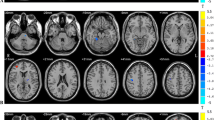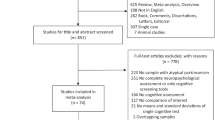Abstract
Fatigue is a non-specific symptom that is common in chronic diseases and represents one of the most disabling symptoms in Parkinson’s disease. PD patients often experience cognitive deficits related above all to executive functions. The relationship between cognitive changes and fatigue in PD patients has not been explored in depth. The Attention Network Test (ANT) is a rapid, widely used test to measure the efficiency of three attentional networks, i.e., alerting, orienting, and executive, by evaluating reaction times (RTs) in response to visual stimuli. To assess the association between fatigue and the efficiency of the attentional networks, according to the Posnerian view, ANT was administered to 15 parkinsonian patients with fatigue (PFS-16 > 2.95), 17 parkinsonian patients without fatigue, and 37 age- and sex-matched healthy controls. Anxiety, depression, quality of sleep, and quality of life were also assessed. Parkinsonian patients displayed significantly longer RTs and lower executive network efficiency than controls. Patients with fatigue displayed significantly lower executive network efficiency than patients without fatigue. Moreover, patients with fatigue exhibited a lower accuracy than either patients without fatigue or controls. Finally, patients without fatigue displayed a more efficient alerting network than either patients with fatigue or controls. Although the pathogenesis of fatigue is multifactorial, our results indicate that fatigue may be closely related to an alteration of the striato-thalamo-cortical loop connecting the neostriatum to the prefrontal cortex, which is also responsible for the executive dysfunction that is typical of Parkinson’s disease.



Similar content being viewed by others
References
Abe K, Takanashi M, Yanagihara T (2000) Fatigue in patients with Parkinson’s disease. Behav Neurol 12:103–106
Amabile G, Fattapposta F, Pozzessere G et al (1986) Parkinson disease: electrophysiological (CNV) analysis related to pharmacological treatment. Electroencephalogr Clin Neurophysiol 64:521–524
Beck AT, Ward CH, Mendelson M, Mock J, Erbaugh J (1961) An inventory for measuring depression. Arch Gen Psychiatry 4:561–571
Berardelli A, Rothwell JC, Thompson PD, Hallett M (2001) Pathophysiology of bradykinesia in Parkinson’s disease. Brain 124:2131–2146
Boksem MA, Tops M (2008) Mental fatigue: costs and benefits. Brain Res Rev 59:125–139
Brown RG, Dittner A, Findley L, Wessely SC (2005) The Parkinson fatigue scale. Parkinsonism Relat Disord 11:49–55
Brown RG, Marsden CD (1988) Internal versus external cues and the control of attention in Parkinson’s disease. Brain 111:323–345
Buysse DJ, Reynolds CF III, Monk TH, Berman SR, Kupfer DJ (1989) The Pittsburgh Sleep Quality Index: a new instrument for psychiatric practice and research. Psychiatry Res 28:193–213
Castrioto A, Thobois S, Carnicella S, Maillet A, Krack P (2016) Emotional manifestations of PD: Neurobiological basis. Mov Disord 31(8):1103–1113
Chaudhuri A, Behan PO (2000) Fatigue and basal ganglia. J Neurol Sci 179:34–42
Chaudhuri A, Behan PO (2004) Fatigue in neurological disorders. Lancet 363:978–988
Coull JT (1998) Neural correlates of attention and arousal: insights from electrophysiology, functional neuroimaging and psychopharmacology. Prog Neurobiol 55:343–361
Corbetta M, Shulman GL (2002) Control of goal-directed and stimulus-driven attention in the brain. Nat Rev Neurosci 3:201–215
Cristinzio C, Bononi M, Piacentini S, Albanese A, Bartolomeo P (2013) Attentional networks in Parkinson’s disease. Behav Neurol 27:495–500
Fabbrini G, Latorre A, Suppa A, Bloise M, Frontoni M, Berardelli A (2013) Fatigue in Parkinson’s disease: motor or non-motor symptom? Parkinsonism Relat Disord 19:148–152
Fan J, McCandliss BD, Fossella J, Flombaum JI, Posner MI (2005) The activation of attentional networks. Neuroimage 26:471–479
Fan J, McCandliss BD, Sommer T, Raz A, Posner MI (2002) Testing the efficiency and independence of attentional networks. J Cogn Neurosci 14:340–347
Fattapposta F, Pierelli F, My F et al (2002) L-dopa effects on preprogramming and control activity in a skilled motor act in Parkinson’s disease. Clin Neurophysiol 113:243–253
Friedman JH, Alves G, Hagell P et al (2010) Fatigue rating scales critique and recommendations by the Movement Disorders Society Task Force on Rating Scales for Parkinson’s disease. Mov Disord 25:805–822
Friedman JH, Brown RG, Comella C et al (2007) Fatigue in Parkinson’s disease: a review. Mov Disord 22:297–308
Gibb WR, Lees AJ (1988) The relevance of the Lewy body to the pathogenesis of idiopathic Parkinson’s disease. J Neurol Neurosurg Psychiatry 51:745–752
Han Y, Cheng H, Toledo JB, Wang X et al (2016) Impaired functional default mode network in patients with mild neurological Wilson’s disease. Parkinsonism Relat Disord 30:46–51
Havlikova E, Rosenberger J, Nagyova I et al (2008) Impact of fatigue on quality of life in patients with Parkinson’s disease. Eur J Neurol 15:475–480
Herlofson K, Larsen JP (2003) The influence of fatigue on health-related quality of life in patients with Parkinson’s disease. Acta Neurol Scand 107(1):1–6
Holtzer R, Shuman M, Mahoney JR, Lipton R, Verghese J (2011) Cognitive fatigue defined in the context of attention networks. Neuropsychol Dev Cogn B Aging Neuropsychol Cogn 18:108–128
Kluger BM, Herlofson K, Chou KL et al (2016) Parkinson’s disease-related fatigue: a case definition and recommendations for clinical research. Mov Disord 31:625–631
Lou JS, Benice T, Kearns G, Sexton G, Nutt J (2003) Levodopa normalizes exercise related cortico-motoneuron excitability abnormalities in Parkinson’s disease. Clin Neurophysiol 114:930–937
Low KA, Miller J, Vierck E (2002) Response slowing in Parkinson’s disease: a psychophysiological analysis of premotor and motor processes. Brain 125:1980–1994
Measso G, Cavarzeran F, Zappalà G et al (1993) The Mini-Mental State Examination: normative study of an Italian random sample. Dev Neuropsychol 9:77–85
Pauletti C, Mannarelli D, De Lucia MC et al (2015) Selective attentional deficit in essential tremor: evidence from the attention network test. Parkinsonism Relat Disord 21:1306–1311
Pavese N, Metta V, Bose SK, Chaudhuri KR, Brooks DJ (2010) Fatigue in Parkinson’s disease is linked to striatal and limbic serotonergic dysfunction. Brain. 133:3434–3443
Petersen SE, Posner MI (2012) The attention system of the human brain: 20 years after. Annu Rev Neurosci 35:73–89
Peto V, Jenkinson C (1995) The development and validation of a short measure of functioning and well being for individuals with Pakinson`s disease. Qual Life Res 4:241
Pillon B, Czernecki V, Dubois B (2003) Dopamine and cognitive function. Curr Opin Neurol 16(Suppl 2):S17–S22
Posner MI (2008) Measuring alertness. Ann N Y Acad Sci 1129:193–199
Posner MI (2012) Imaging attention networks. NeuroImage 61:450–456
Posner MI, Petersen SE (1990) The attention system of the human brain. Annu Rev Neurosci 13:25–42
Raz A (2004) Anatomy of attentional networks. Anat Rec B New Anat 281:21–36
Raz A, Buhle J (2006) Typologies of attentional networks. Nat Rev Neurosci 7:367–379
Rochester L, Hetherington V, Jones D, Nieuwboer A, Willems AM, Kwakkel G, Van Wegen E (2004) Attending to the task: interference effects of functional tasks on walking in Parkinson’s disease and the roles of cognition, depression, fatigue, and balance. Arch Phys Med Rehabil 85:1578–1585
Shulman LM, Taback RL, Bean J, Weiner WJ (2001) Comorbidity of the nonmotor symptoms of Parkinson’s disease. Mov Disord 16:507–510
Solís-Vivanco R, Rodríguez-Violante M, Rodríguez-Agudelo Y, Schilmann A, Rodríguez-Ortiz U, Ricardo-Garcell J (2015) The P3a wave: A reliable neurophysiological measure of Parkinson’s disease duration and severity. Clin Neurophysiol 126:2142–2149
Spielberger CD (1983) Manual for the state-trait anxiety inventory (self-evaluation questionnaire). Consulting Psychologists Press, Palo Alto
Stanzione P, Fattapposta F, Giunti P et al (1991) P300 variations in parkinsonian patients before and during dopaminergic monotherapy: a suggested dopamine component in P300. Electroencephalogr Clin Neurophysiol 80:446–453
Stocchi F, Abbruzzese G, Ceravolo R et al (2014) Prevalence of fatigue in Parkinson disease and its clinical correlates. Neurology 83:215–220
van Hilten JJ, Weggeman M, van der Velde EA, Kerkhof GA, van Dijk JG, Roos RA (1993) Sleep, excessive daytime sleepiness and fatigue in Parkinson’s disease. J Neural Transm Park Dis Dement Sect 5:235–244
Vandenbossche J, Deroost N, Soetens E et al (2012) Conflict and freezing of gait in Parkinson’s disease: support for a response control deficit. Neuroscience 206:144–154
Wang K, Fan J, Dong Y, Wang CQ, Lee T, Posner MI (2005) Selective impairment of attentional networks of orienting and executive control in schizophrenia. Schizophr Res 78:235–241
Yang B, Wang X, Shen L et al (2015) The attentional networks in benign epilepsy with centrotemporal spikes. Epilepsy Behav 53:78–82
Zhou S, Chen X, Wang C, Yin C, Hu P, Wang K (2012) Selective attention deficits in early and moderate stage Parkinson’s disease. Neurosci Lett 509:50–55
Author information
Authors and Affiliations
Corresponding author
Ethics declarations
Conflict of interest
The authors declare that they have no conflict of interest.
Rights and permissions
About this article
Cite this article
Pauletti, C., Mannarelli, D., Locuratolo, N. et al. Attention in Parkinson’s disease with fatigue: evidence from the attention network test. J Neural Transm 124, 335–345 (2017). https://doi.org/10.1007/s00702-016-1637-z
Received:
Accepted:
Published:
Issue Date:
DOI: https://doi.org/10.1007/s00702-016-1637-z




